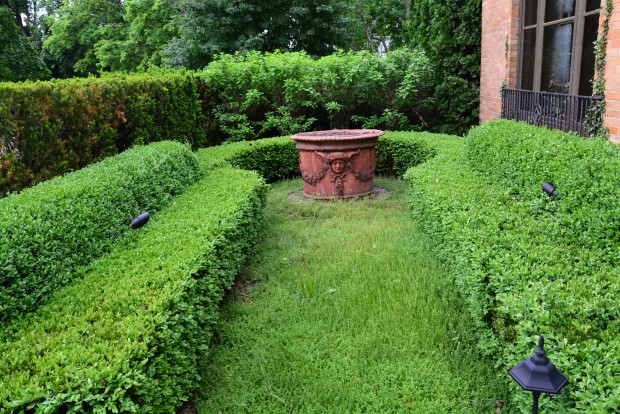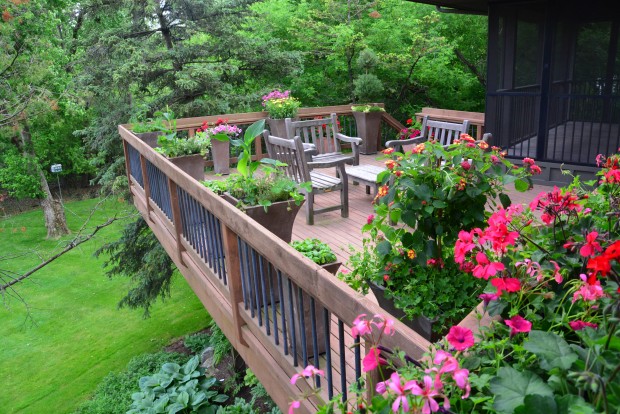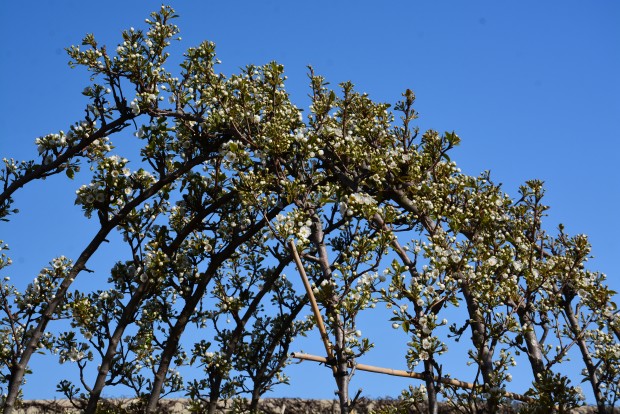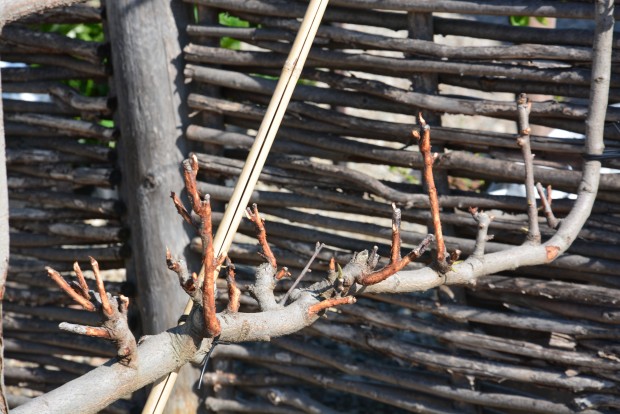 We have had an astonishing amount of rain in the past three weeks. Steady and generous rain. Lately that rain has been accompanied by very warm temperatures. Timing is everything-as someone once said. I am watching what regular spring rain and a little heat is meaning to my plants. All of my evergreens, shrubs and perennials are putting on a lot of weight. I am delighted with the look. It is no news that every living thing needs water to survive. You, me, the trees, and the planet. Some plants need next to no water-that would be the succulents on the roof of the Vatican that have been there hundreds of years, they get vastly less than 3 inches of rain a year. Some need regular water and boggy conditions-as in Louisiana iris. All those plants in the middle of this spectrum, in my area, are soaking wet, and growing happy.
We have had an astonishing amount of rain in the past three weeks. Steady and generous rain. Lately that rain has been accompanied by very warm temperatures. Timing is everything-as someone once said. I am watching what regular spring rain and a little heat is meaning to my plants. All of my evergreens, shrubs and perennials are putting on a lot of weight. I am delighted with the look. It is no news that every living thing needs water to survive. You, me, the trees, and the planet. Some plants need next to no water-that would be the succulents on the roof of the Vatican that have been there hundreds of years, they get vastly less than 3 inches of rain a year. Some need regular water and boggy conditions-as in Louisiana iris. All those plants in the middle of this spectrum, in my area, are soaking wet, and growing happy.
 Water from the hose, or an irrigation system, is nothing like water from the sky. I have no science whatsoever to back up this assertion, but I believe that water from the sky is like no other water. Water from the sky is imbued and super charged with life. This natural water makes everything explode with growth. A rainy spring day is great for the garden in my zone.
Water from the hose, or an irrigation system, is nothing like water from the sky. I have no science whatsoever to back up this assertion, but I believe that water from the sky is like no other water. Water from the sky is imbued and super charged with life. This natural water makes everything explode with growth. A rainy spring day is great for the garden in my zone.
 Every plant in my garden is going shoulder to shoulder, given the steady rain. No fertilizer at work here. Just good soil that gets a top dressing of ground hardwood bark mulch once in a while, and steady rain. Not every spring is like this. Dry springs make for plants with a much more lean silhouette. Dry springs make every plant look needy. My plants look ready to to talk to me.
Every plant in my garden is going shoulder to shoulder, given the steady rain. No fertilizer at work here. Just good soil that gets a top dressing of ground hardwood bark mulch once in a while, and steady rain. Not every spring is like this. Dry springs make for plants with a much more lean silhouette. Dry springs make every plant look needy. My plants look ready to to talk to me.
 This rhododendron is closing in on 30 years old. It is blooming profusely this year. I credit the regular spring rain. I do nothing to look after it, except to pinch off the dead flower heads. Just outside my home office window, it is a delight. This late May explosion of form and color is a delight.
This rhododendron is closing in on 30 years old. It is blooming profusely this year. I credit the regular spring rain. I do nothing to look after it, except to pinch off the dead flower heads. Just outside my home office window, it is a delight. This late May explosion of form and color is a delight.
 The ivy growing across my side door steps has been there for 30 years as well, but is looking particularly lush this year.
The ivy growing across my side door steps has been there for 30 years as well, but is looking particularly lush this year.
 The beech ferns and European ginger have decided to come on. I was worried that our extremely cold winter would do them in-but not so. They were slow to show, until the rains came.
The beech ferns and European ginger have decided to come on. I was worried that our extremely cold winter would do them in-but not so. They were slow to show, until the rains came.
 The Princeton Gold maples are in full and glorious leaf. Each leaf is bigger than my hand. All of the yews are sending forth their new growth. The fountain garden is dominated by lime green, in various shapes and forms. As busy as I am, all this spring lime is arresting, and compelling.
The Princeton Gold maples are in full and glorious leaf. Each leaf is bigger than my hand. All of the yews are sending forth their new growth. The fountain garden is dominated by lime green, in various shapes and forms. As busy as I am, all this spring lime is arresting, and compelling.
 The boxwoods have begun to grow. The late afternoon light pictures that growth as another shade of lime. Hellebores just planted last summer are sending up new leaves. This is a spring view of my garden that gives me so much pleasure.
The boxwoods have begun to grow. The late afternoon light pictures that growth as another shade of lime. Hellebores just planted last summer are sending up new leaves. This is a spring view of my garden that gives me so much pleasure.
 The clematis on the bench have grown by leaps and bounds. The buds are coming on strong. They are starting to lean on my moss cow, Lady Miss Bunny, for support. The pachysandra is loaded with limey green spring growth. Milo’s path through it is obvious. When the new growth hardens off, his tracks will recede.
The clematis on the bench have grown by leaps and bounds. The buds are coming on strong. They are starting to lean on my moss cow, Lady Miss Bunny, for support. The pachysandra is loaded with limey green spring growth. Milo’s path through it is obvious. When the new growth hardens off, his tracks will recede.
 When I see plants in my garden growing lustily, I am thrilled. I have gardened long enough to know that I am a second tier provider to my garden. Nature calls the shots. And I am well aware than nature bats last.
When I see plants in my garden growing lustily, I am thrilled. I have gardened long enough to know that I am a second tier provider to my garden. Nature calls the shots. And I am well aware than nature bats last.
 Buck and I sit here every night, after work. We have nothing to look at in the way of roses. This past winter finished all of the last of them off. But every night I look at that space, and try to imagine what might be. But behind us, the boxwood is responding to all of the rain. We have a dialogue going on. Spring talk-every gardener understands this.
Buck and I sit here every night, after work. We have nothing to look at in the way of roses. This past winter finished all of the last of them off. But every night I look at that space, and try to imagine what might be. But behind us, the boxwood is responding to all of the rain. We have a dialogue going on. Spring talk-every gardener understands this.
 The May rain we have had has my garden bursting at the seams. Nature at its most helpful and benign makes me look good. I have a lush garden life right now. For this, I am grateful. My spring could have been very different from this. Nature has her own agenda. She takes no direction. Nature is a wild force that knows no bounds.
The May rain we have had has my garden bursting at the seams. Nature at its most helpful and benign makes me look good. I have a lush garden life right now. For this, I am grateful. My spring could have been very different from this. Nature has her own agenda. She takes no direction. Nature is a wild force that knows no bounds.
 Though my garden is as green and growing as it could possibly be, I think about people, farmers, and gardeners in California who are suffering from terrible drought. Would that I could FedEx them some of my spring rain. The people in Texas enduring devastating flooding from heavy rains-terrible. Texas has a long history of flooding, but who cares about the history? Any person in Texas whose house has been swept away by too heavy spring rains-I feel terrible for their loss and anguish. We have had rain that sustains. This is my report, for my vicinity. As for the rain that nature delivers-rain in one place is a gift. Mad and unrelenting rain somewhere else could be a disaster.
Though my garden is as green and growing as it could possibly be, I think about people, farmers, and gardeners in California who are suffering from terrible drought. Would that I could FedEx them some of my spring rain. The people in Texas enduring devastating flooding from heavy rains-terrible. Texas has a long history of flooding, but who cares about the history? Any person in Texas whose house has been swept away by too heavy spring rains-I feel terrible for their loss and anguish. We have had rain that sustains. This is my report, for my vicinity. As for the rain that nature delivers-rain in one place is a gift. Mad and unrelenting rain somewhere else could be a disaster.
 The spring water from the sky can be good. Too much water from the sky can destroy lives. Nature is not a friendly force. Nature has her own schedule. Never mind any of us. She does not call for a meeting, before she delivers her water. Her water can be a steady fall over a number of hours. Or it could be a deluge in minutes. That water could sustain life. Or it could wash away lives.
The spring water from the sky can be good. Too much water from the sky can destroy lives. Nature is not a friendly force. Nature has her own schedule. Never mind any of us. She does not call for a meeting, before she delivers her water. Her water can be a steady fall over a number of hours. Or it could be a deluge in minutes. That water could sustain life. Or it could wash away lives.
 I am thinking about rain right now. There is no easy answer. Generous rain endows every garden. Torrential rains can be so distructive. Nature is a very, very, and more very a wild card. Gardeners know this.
I am thinking about rain right now. There is no easy answer. Generous rain endows every garden. Torrential rains can be so distructive. Nature is a very, very, and more very a wild card. Gardeners know this.


















